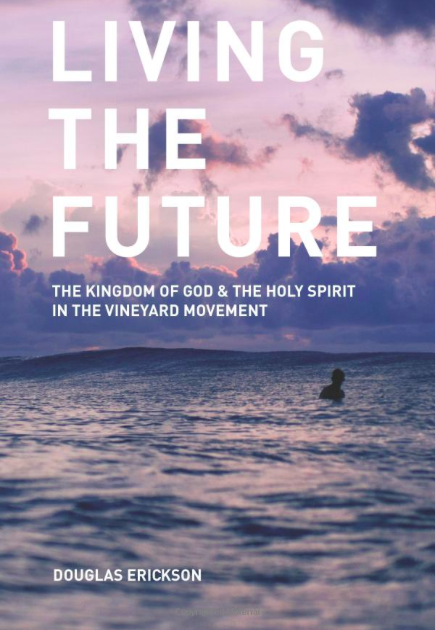Book Review: Living the Future, The Kingdom of God and Holy Spirit in the Vineyard Movement Part 1

This review was written by Dave Hanson Executive Director, Sunrise Outreach Center Co-Pastor, Vineyard Christian Fellowship of Yakima.
The book Living the Future: The Kingdom of God and Holy Spirit in the Vineyard Movement, by Dr Douglas R. Erickson, PhD, is both the collective formulation of Vineyard Theology and its historic centered expression. I found this book a difficult read in places; but from a non-collegiate perspective, pushing through it became well worth that effort for me. This is the progression of the Vineyard movement, where it came from, how it got here and how it functions today. Vineyard’s inaugurated enacted eschatology is this book’s central thesis, how we ‘Live the Future’. A defined Vineyard pneumatology is an important contribution. The question presents itself here; does the Vineyard movement actually practice and reflect this thesis as distinct; are we living the future?
The book is broken down into 5 Sections with multiple chapters dispersed throughout. At the end of each section, there are a number of questions listed for discussion. I thought this brought a great deal of reflection on key points and it makes an ideal small group discussion format.
Section I is a detailed and well written story of John Wimber and his construct of the Vineyard movement. I think this is a very important contribution to the Vineyard movement. It tells the story of John; how he was a regular guy, his struggle with the problems of life, how he found his faith, and ultimately how a movement was born. It talks about how he was influenced, what moved him; how he was able to cross so many ecumenical barriers to develop a balanced view he could settle on. Forty years into this movement, as one generation is replaced by another, having this story documented in so detailed a manner will have long lasting benefits. The mission of the church as stated consistently throughout this book is “doing the works and preaching the words of Jesus”.
There is little structure to Vineyard in terms of denominational structure, leadership or offices. Wimber’s ‘centered-set’ model is still very much in place today. As expected, there is a wide variety of practices among Vineyard churches regarding church membership, how offices and leadership of the church are structured, how ordinances like baptism and Eucharist are practices, and how ordination is granted to pastors. Dr Erickson does point out here that some issues appear to be settled: the role of women in ministry, for example.
He goes on to say: A comprehensive Vineyard ecclesiology would have to build on the foundational values and theology already in place; i.e., everyone gets to play, the ministry of the Spirit, inaugurated enacted eschatology, and culturally relevant mission. Being aware of the strengths and weaknesses of the centered-set model, and yet be elastic enough to incorporate global expressions of “what it means to be Vineyard” in cultures dramatically different from middle-class suburban America.
Towards a Vineyard Theology of Justice
This is the area I wanted to focus on because of my passion and experience within the Vineyard movement. The Vineyard in Yakima, Washington, built a non-profit called Sunrise Outreach Center. It is the outreach ministry of the Yakima Vineyard Church. As I read this book, I contrasted what was being said with what was actually being done here in our community. Although a comprehensive Vineyard theology of justice has not yet been developed, the expression of Vineyard’s inaugurated enacted kingdom of God theology is nevertheless being practiced, or at least being developed here. When I read about the original Vineyard Genetic Code, which included valuing the scriptures, spiritual gifts, training, ministry to the poor, evangelism and ecumenical relationships, I could see how these were being developed in Yakima. A sound bite that we use there is “There are people in need, and others who want to help; we’re interested in both.” “God is working as much with those who’ve come to help and those they’ve come to serve.” Living the Future appears to be taking shape here. It’s like a training ground where spiritual gifts become evident in community interaction. Healing and ministry to the poor develop across a large spectrum of ecumenical relationships. Ministries include five food pantries across the county, all run by indigenous community volunteers. Both adults and children are being fed daily; one outreach is at our church and another for children at one of the poorest schools in our county 40 minutes away. We have three trauma informed staffed residential and education centers for teens 12 to 18 years of age, two of which are for sex trafficked teen girls. We network with many other churches in the community to provide shelter and housing for homeless. The Vineyard serves in a central capacity.
I loved this quote in the book: “It seems like the Vineyard identity, expressed through the DNA and a commitment to be centered-set, is more an ethos or approach than a set of rules, doctrinal beliefs or demands.” “Many people don’t ‘become’ Vineyard; they discover that they ‘are’ Vineyard.” I think this has been the case for me.
From a Vineyard Justice Network perspective, there are currently ministries to the poor, the oppressed and victimized, all across the country. Human trafficking, immigration, caring for the planet and many other ministries are also building throughout the Vineyard.
While there have been conferences which have focused on Justice and specific initiatives in the movement, “a comprehensive theology of justice has not yet been developed.”
…
